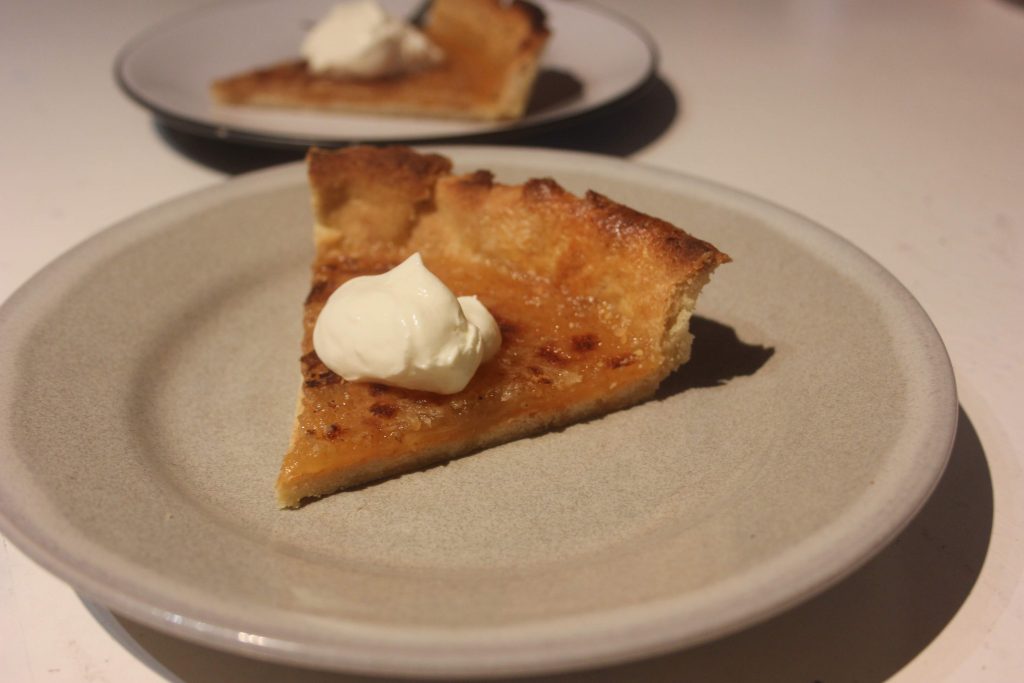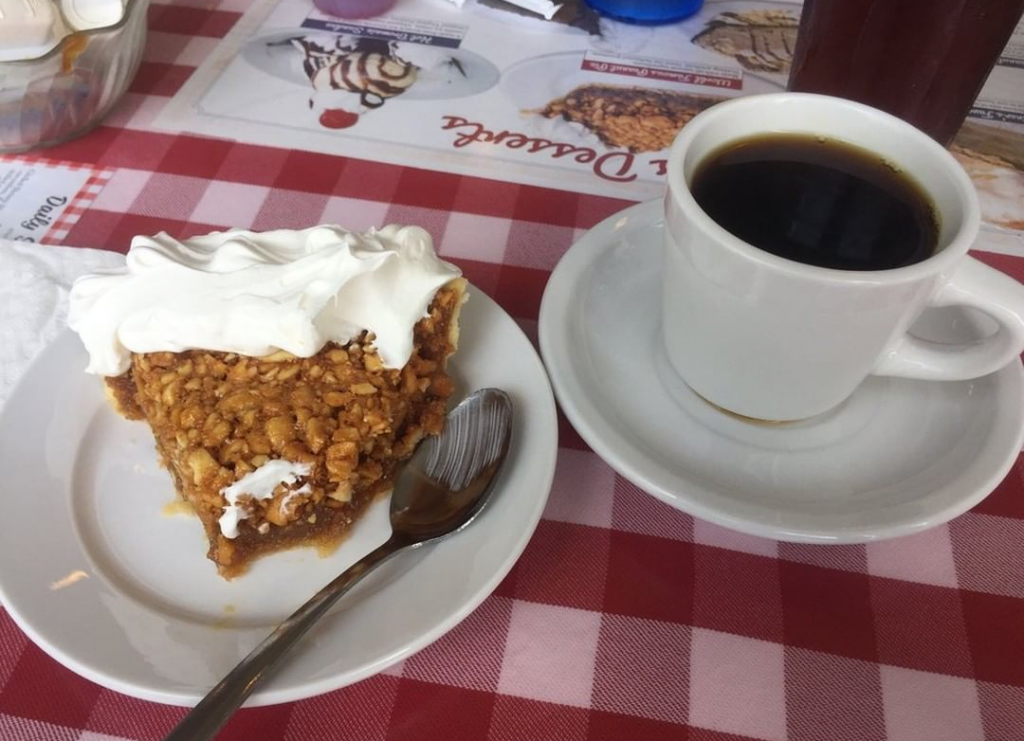Pie is a cornerstone of American cuisine. Whether apple, pumpkin, sweet potato or pecan—we can’t get enough.
Those specific pies are nationally appreciated, but they’re also specific to Appalachia. Apples grow abundantly in the region and, in the South, sweet potatoes are a staple crop. Pecan pies are especially popular in Kentucky and Tennessee, where a bit of bourbon is often added.
Some other pies from the region, however, have gone underappreciated. Vinegar, shoofly, and peanut pie, for example, are all a product of crafty thinking. During tough times, Appalachians used what was readily available, inventing the shoofly and vinegar pies. Likewise, Appalachians made the most out of crops that were abundant in specific parts of the region, as in the case of peanut pie. Apples and pecans are seasonally available in certain areas, too, but are more expensive, whereas vinegar, molasses, and peanuts were affordable and easier to find (or grow) year-round.
Vinegar pie

Vinegar pie is a West Virginian classic. Lemons are not a fruit native to West Virginia, so some savvy cooks developed an alternative— vinegar. Vinegar pie, also known as desperation pie, is associated with tough times. I, like Mike Costello—the West Virginia chef, writer, and homesteader-extraordinaire—believe that we should reframe how we classify this and other “desperation pies.”
Costello penned an article on the topic for Anthony Bourdain’s Parts Unknown in 2018: “When I think about the negative connotations of the term desperation, I find myself wondering if such dishes shouldn’t be known as ‘innovation pies’ instead,” he wrote.
In addition to West Virginians, vinegar innovation pie was popular with pioneers and those during the Great Depression. Many vinegar pie recipes circulate around the internet, but the one Costello shared (found in a 1930s newspaper) seems especially scrumptious.
Shoofly pie

The Atlanta-based Zac Brown Band declares their love for shoofly pie in their cover of a song aptly named “Shoofly Pie.” My favorite part of the song goes:
Don’t forget the sweet molasses
I won’t leave a crumb
And don’t you just sit there laughin’
‘Cause you know how bad I need some
You know how bad I need some of that
The shoofly pie has a dedicated fan base. This innovation pie is attributed to the Pennsylvania Dutch, though its origin story is not entirely clear. One theory is that the pie originated in Philadelphia but as a cake. The Pennsylvania Dutch liked the cake, the story goes, and added a crust so it could be eaten by hand.
Another theory asserts that the pie came into existence in the 18th century shortly after Germanic immigrants arrived in Pennsylvania. Pie-making was not a culinary tradition of those immigrants so it has been suggested that they adopted the technique from their English neighbors. Although molasses is the primary ingredient in shoofly pies, sorghum was originally used. As I discussed in “Sweet Like Sorghum: Sorghum’s Journey to Appalachia,” sugar became a global commodity—and a cheap one at that. That price change likely explains sorghum’s replacement for molasses in the shoofly pie.
Today, shoofly pie is a fixture at Amish shops. “Pennsylvania Dutch” is often used as a synonym for Amish, but there is a distinction. Pennsylvania Dutch refers to a wider cultural group of Germanic immigrants to Pennsylvania, whereas Amish denotes a specific religious group within it.
It is very possible that the dispersal of Amish people throughout the US contributed to the shoofly pie becoming a part of American culture. With large Amish communities in Pennsylvania and Ohio, and other sizable (in Kentucky and Tennessee) and smaller (in West Virginia, Virginia, and North Carolina) communities throughout Appalachia, it seems fair to make a connection between this and the pie’s adoption in Appalachian culture.
The best part about shoofly pie, much like vinegar pie, is that the ingredients are easy to find and the pie itself is super simple to prepare. Another plus is that the pie does not need to be refrigerated.
There are dozens of recipes available, but this one found and recreated by The New York Times looked especially good.
Peanut pie

This pie is claimed by Virginians, from where the iconic ballpark peanut variety, aptly named the Virginia peanut, comes. Although Virginia has a claim to the peanut by name, the majority of Virginia peanuts in the US are grown in Virginia and the Carolinas. Thus, the popularity of the peanut pie extends south as far as Georgia.
Unlike the other innovation pies that came from working with limited local ingredients, the peanut pie made the most of a newly local ingredient. It was often referred to as the “poor man’s pecan pie,” though the name has more to do with racism than the cheap price of peanuts.
Originating in the New World, peanuts were first cultivated in Meso- and South America. When the Spanish arrived in the New World they learned of peanuts and then took them back to Europe. From Europe, traders transported the nut to Asia and Africa. By the 1700s, the African slave trade was underway and the people forced into slavery brought many foods with them to America, including the peanut.
Since peanuts were associated with enslaved people, racism led many people to reject peanuts. Once the Civil War was over, the popularity of peanuts grew. Industrialization, labor-saving equipment, and the research of George Washington Carver all helped expand the peanut industry in the US.
All that time, enslaved people had been enjoying peanut dishes, including peanut pie. The irony now is that once stigmatized, peanut pie has become a much-loved part of Virginia culture.
Like the other innovation pies, peanut pie has a simplistic elegance about it. The Old Farmer’s Almanac offers a delicious looking version to try.
Did I miss an innovation pie you love? Tell me about it at annie@expatalachians.com.
Annie Chester is a writer and co-founder of expatalachians. She writes about the environment and culture in Appalachia and abroad. She is currently a postgraduate student at the University of Edinburgh in Scotland.
Subscribe to The Patch, our newsletter, to stay up-to-date with new expatalachians articles and news from around Appalachia.


